
The vast majority of parents do everything possible to provide their children with the best information and tools to give them the opportunity for a successful life. They are, in a sense, a blank canvas. On that canvas, we paint our dreams and expectations for a bright and promising future. We try to make sure that we pass on all of the useful information that we learned when we were growing up. At the same time, we try to learn from any of the mistakes that our parents made, and not repeat those same mistakes with our children. More often than not, these mistakes were not intentional, but we may have found that certain things that were taught to us were not as helpful as we would have liked, so we seriously attempt to avoid passing them on to our children.
Most of us never give serious thought to how our children learn and develop survival skills and behavior patterns. Surprisingly, children will learn 75% of the basic tools and concepts that they will use throughout their lives by the age of three years old. Even before they have developed any advanced communication skills, they have learned these things from watching what those around them do and listening to how they deal with day-to-day issues. Children learn an additional 20% of these skills, which will define how they deal with daily issues, in the next 10 to 12 years. As a result, 95% of their decision making powers are established by the age of 15 years old. This is not a recent discovery, but certainly not one of which many parents are aware. Our children model our behavior patterns, even when we hope they are not paying attention.
An easy way to see this is when your children say things that you deem inappropriate. Sometimes you may hear your child make a critical comment of another that you feel is inappropriate, only to discover that they are repeating something that you said. You may have heard your child say something that you consider to be “adult language”, and found yourself shocked that those words came from your child’s mouth. When you quiz them about it, they often say, “but you said that!”
The mind of a child is like a sponge, and soaks up everything with which it comes in contact. Our children are not only listening to what we say, but also what they hear from others and through television, video games, and everything else around them. Part of our job as parents it to try to act as a filter and correct any misinformation they are absorbing before it becomes an established part of their Belief System.
Unfortunately, however, any misinformation that we may have learned and set in our own Belief Systems, as we were growing up, is likely to be passed on as well. This is particularly true when it comes to how to successfully deal with losses in our lives.

How did we learn about coping with grief?
Take a moment and try to recall how you learned to cope with grief as a child. Did a parent or trusted adult sit you down on their knee and try to explain to you how to deal with the emotional pain of a broken or lost toy, or the friend who knocked you to the ground when you were playing? In all likelihood they probably never even thought of this as a potential grief issue. Most people equate grief with a death, but do not realize that every change we encounter in life has elements of grief attached. Grief is the normal and natural response to change of any kind. It is part of being human.
When, as a child, you encountered an experience of this type, it is likely that the adults around you gave you a variety of logical reasons why you should stop feeling sad. Now ask yourself if these intellectual reasons actually made you feel better? Chances are they did not, but you tried to put on a brave face, because you were trying to follow directions from someone in whom you had trust. What you were doing was suppressing and burying your feelings, because that was your perception of what you thought you were supposed to do in that situation. Without even realizing it, you were establishing the first behavior pattern, that you would use for the rest of your life, in dealing with loss of any kind. The underlying message was that you could use logic to deal with your emotions, and that the best way to deal with sad emotions was to stuff them!
Grief is an emotion!
No matter how you try to use logic to deal with the emotional pain of grief, that grief still exists. You may convince yourself that the emotional pain is relatively insignificant, but the fact that you actually feel it shows just how significant that pain was in the moment it occurred.
How do parents try to help you children “feel better?”
When we see our children are upset about anything, it is only natural to want them to feel better. Trying to minimize that pain with reasons why they should not feel bad, may give us the sense that they are feeling better when the tears stop flowing, but it is not really helping them to learn how to effectively deal with pain in their lives. Nor is offering them a treat if they will stop crying. This is simply suggesting to them that there are rewards for hiding their feelings. Doctors used to regularly give children a lollipop as a reward for getting a shot. If this happened to you, did that shot hurt any less? Probably not. But now you were beginning to equate a sweet as a positive way to deal with the feelings that you were burying inside.
The reason that we are spending all of this time in reminding you of possible childhood experiences is to establish how you learned your first skills in dealing with loss. If you are now beginning to remember the limited value these things really had on dealing with those feelings that you experienced, you will be in a better position to see that these may not be the best tools for you to pass on to your children.
While we are generally very good in accepting happiness in our children, most of us, without even realizing it, send our children messages on a regular basis that sad or unhappy feelings are unacceptable. We tell them such things as:
- Big girls and boys don’t cry!
- If you are going to cry, go to your room!
- You need a time out!
- Don’t be a cry baby!
- Laugh, and the word laughs with you; cry and you cry alone! (This was my mother’s favorite expression when I was sad.)
So, how can we really help them with dealing with sad events?
Obviously, we do not want our children to be sad. None of us want our children to spend their lives in tears. There are better tools we can offer them, however, to deal with sad and unhappy feelings.
Instead of giving them reasons why they should not cry, we need to offer them the chance to use words to express their feelings.
How do we do this? If you ask them what is wrong, they may actually tell you! It is also possible, if you have a history of giving them logical reason not to cry, that they will tell you little or nothing. That does not mean that you are too late to make a change. It simply means that you need to try a different approach.
The best way to get them to share their feelings is to remember that, as an adult, you may need to go first. You may need to relate to them a similar experience that you had as a child to make it feel safe to them to share their feelings.
For example, if your child’s favorite toy is broken and he or she is now crying or displaying sad or unhappy emotions, you might tell them about how sad you felt when you lost a favorite toy. Then follow this short remembrance by asking them to talk about their feelings related to their loss. In doing this, you have let them know that the feelings of emotional loss are normal and that you really care about their feelings. Given the chance to express this pain lets them put vent to their feelings, rather than just stuffing them inside.
Another example was covered in a previous article about helping children deal with the loss of a pet. Instead of dealing with that emotionally painful loss by just buying them a new pet, you first need to sit down with your child and let him or her express their emotional pain concerning this loss. You can help them in doing this by sharing your memory of how you felt about losing a pet when you were younger. You might talk about the things you had wished you had said to your pet and the things that you had wished you could have done differently with that pet when it was alive. Now you have set the stage for them to “complete” their relationship with their pet, so that they can say goodbye to the pain that they are feeling. Once again, we are simply suggesting that you take the actions that you wish your parents might have taken with you when you were in that situation. (If you were lucky, your parents did take those actions, in which case you simply need to do for your child what your parents did for you!) In doing this, you have provided a mechanism for your child to share their feelings, rather than stuffing them inside.
Grief is cumulative
What many people do not realize is that grief is cumulative. Each loss that is stuffed inside, rather than allowed to be expressed, stays inside. With each loss that is not expressed and released, children (and adults) add to that already expanding stash of internalized pain. The more pain that is stuffed and stored, the less room there is for joy. When that internal kettle of pain becomes filled to the brim, it can burst! That is when we see children (and adults) lash out in anger at the slightest provocation. By simply offering our children a chance to express and share their emotional pain, we can prevent it from reaching this stage.
By establishing this pattern of release at an early age, we are giving our children better tools to deal with the even bigger losses in life.
Thus far, we have spoken about what we, as adults, might classify as “minor grief issue”. While these may seem enormous issues to our children, we know in our hearts that they will face bigger ones in their future.
Once again, we are going to ask you to go back in your memory to that first little boy or girl on whom you had your first childhood crush. I remember when the first little girl who I thought I “loved” in grade school dumped me for another boy she thought was cuter. When my mother saw how sad I was, she told me that “there were a lot of fish in the sea!” To me, she was hardly a fish and I never thought I would get over it. If instead, she had shared how painful it was when this happened to her and invited me to put voice to her about my feelings, rather than minimizing them, I would have recovered far sooner. It would have also lessened the fear that the next girl I liked was eventually going to dump me as well. If we establish a behavior pattern, at an early age, of carrying all of the baggage of past relationships in future ones, rather than having a mechanism for releasing it, we often doom those relationships before they have a chance to begin.
When we move to potentially even more impactful emotional losses, such as the death of a grandparent or other family member or friend, the need for your child to have useful tools for emotional release becomes even more important. As the adult, you need to make this release both possible and safe for your child. You may think that you have to “be strong” for your child. If you do not allow them to see and understand the emotional impact this loss, or a similar one, had on you, they will not have the tools to effectively move through this experience. This means that you need to sit down with them and share the impact this loss (or a similar one) had on you. This does not mean that you have to go into graphic detail, but you need to share enough that it is safe for them to express their feelings as well. In this case, you should ask them if there are things that they wish they could have said to this person or things that they wish they could have done with them. Allowing them to put voice to these feelings will release some of that emotional pain, rather than encouraging them to stuff those feelings and “be strong” as well. Their strength will come from the emotional release that you facilitate.
A key point to remember
When you are inviting your children to share their feelings, you must do this without analysis, criticism, or judgment. You might be tempted to fall back on offering logical and intellectual reasons why they should not feel bad. Do not do this! Let them express their pain, and then invite them to share their fond memories. Once again, this will better help them move beyond the loss, rather than internalizing their feelings.
Some children inadvertently take on feelings of personal responsibility for a loss. I know one little boy who was sure that he made his father die. He had seen people in limousines and kept wishing that he could ride in one. When his father was killed in an accident, his wish came true and he was convinced that somehow he was responsible for his father’s death. Had someone sat down and let him express his feelings and fears in a safe and caring way, this could have been dealt with in that moment, rather than haunting him throughout his childhood.
Some concluding comments and a tool to help you.
Most parents do an amazing job in giving their children the tools that they need to be successful in life. When you think about it, a child is the most complex thing that you will ever bring home that does not come with an instruction manual and further instructions printed on its bottom! The challenge is that we can only pass on to our children the things that we have learned. If you never learned truly useful tools in dealing with loss in your life, you have no useful information to pass on to your children. Please consider purchasing a copy of “When Children Grieve.” This book will give you those tools, no matter the age of your child. It explains how to talk to your children in a safe and caring way about dealing with the losses they experience. It will open the door to better communication with your children, so that when they have real problems, they will feel safe in coming to you for the answers. It will give you the opportunity to be the best parent possible. Children and grief issues go hand in hand, but you can give them the tools to make loss something that they are better able to handle!
A frequently asked questions concerns whether boys and girls are different when it comes to grief. Please check out our article "Do Boys and Girls Grieve Differently?"
You may also find it helpful to click on the link below to learn about the many
"myths" on dealing with loss that we often use ourselves and pass on to our children!
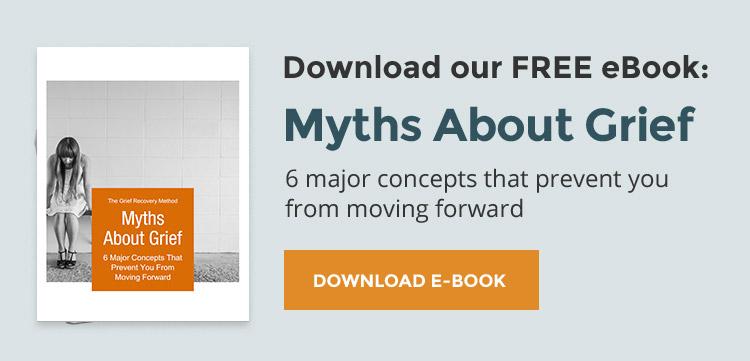
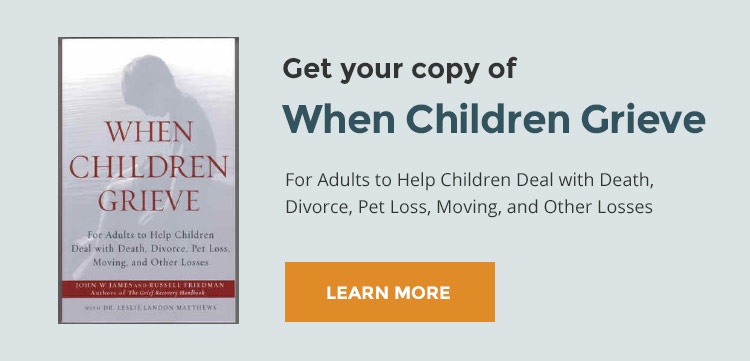











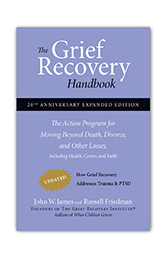
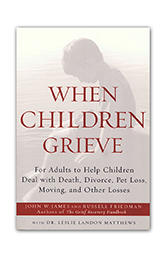
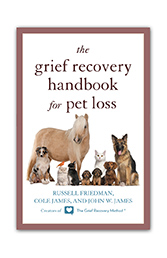
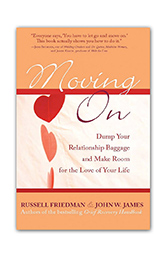
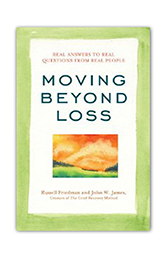






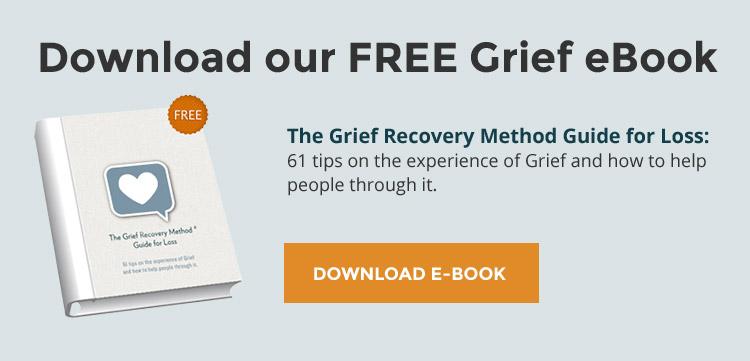
Add new comment